Analyzing Consequences of Biomedical Model in Health Context
VerifiedAdded on 2023/04/05
|10
|2044
|231
Essay
AI Summary
This essay explores the consequences of the biomedical model in understanding health and illness, contrasting it with theories like functionalism and social constructionism. The biomedical model, which primarily focuses on biophysical and genetic malfunctions, is examined for its limitations in considering psychological, environmental, and social determinants of health. The essay highlights how the model's emphasis on laboratory tests over patient history, its neglect of psychological influences, and its disregard for social behaviors like lifestyle and eating habits can lead to incomplete diagnoses and ineffective prevention strategies. Alternative approaches, such as the biopsychosocial model, are presented as more comprehensive frameworks that account for the multifaceted nature of health and illness. The essay concludes by advocating for a holistic approach to healthcare that integrates social determinants to improve diagnostic accuracy and promote overall well-being, emphasizing the importance of prevention over cure.
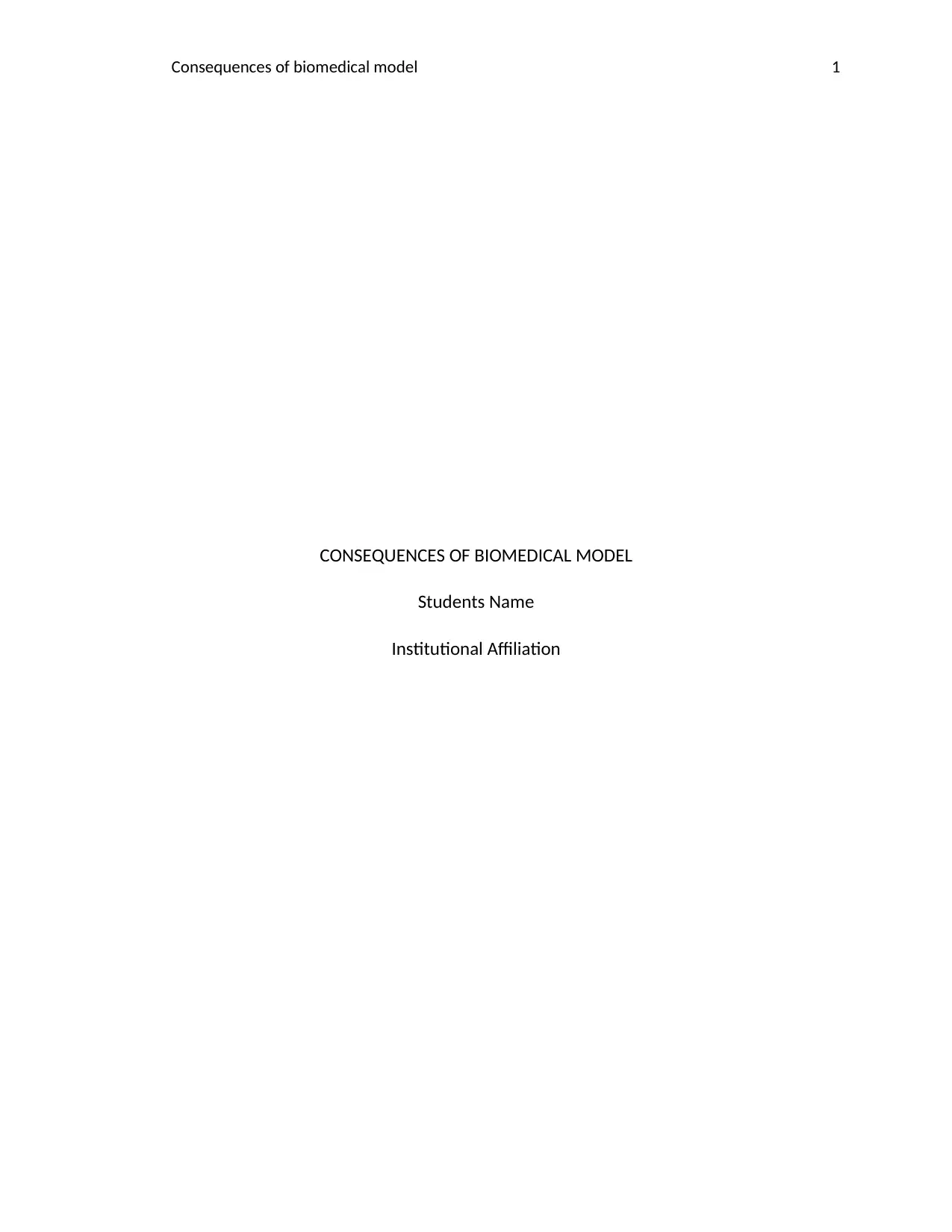
Consequences of biomedical model 1
CONSEQUENCES OF BIOMEDICAL MODEL
Students Name
Institutional Affiliation
CONSEQUENCES OF BIOMEDICAL MODEL
Students Name
Institutional Affiliation
Paraphrase This Document
Need a fresh take? Get an instant paraphrase of this document with our AI Paraphraser
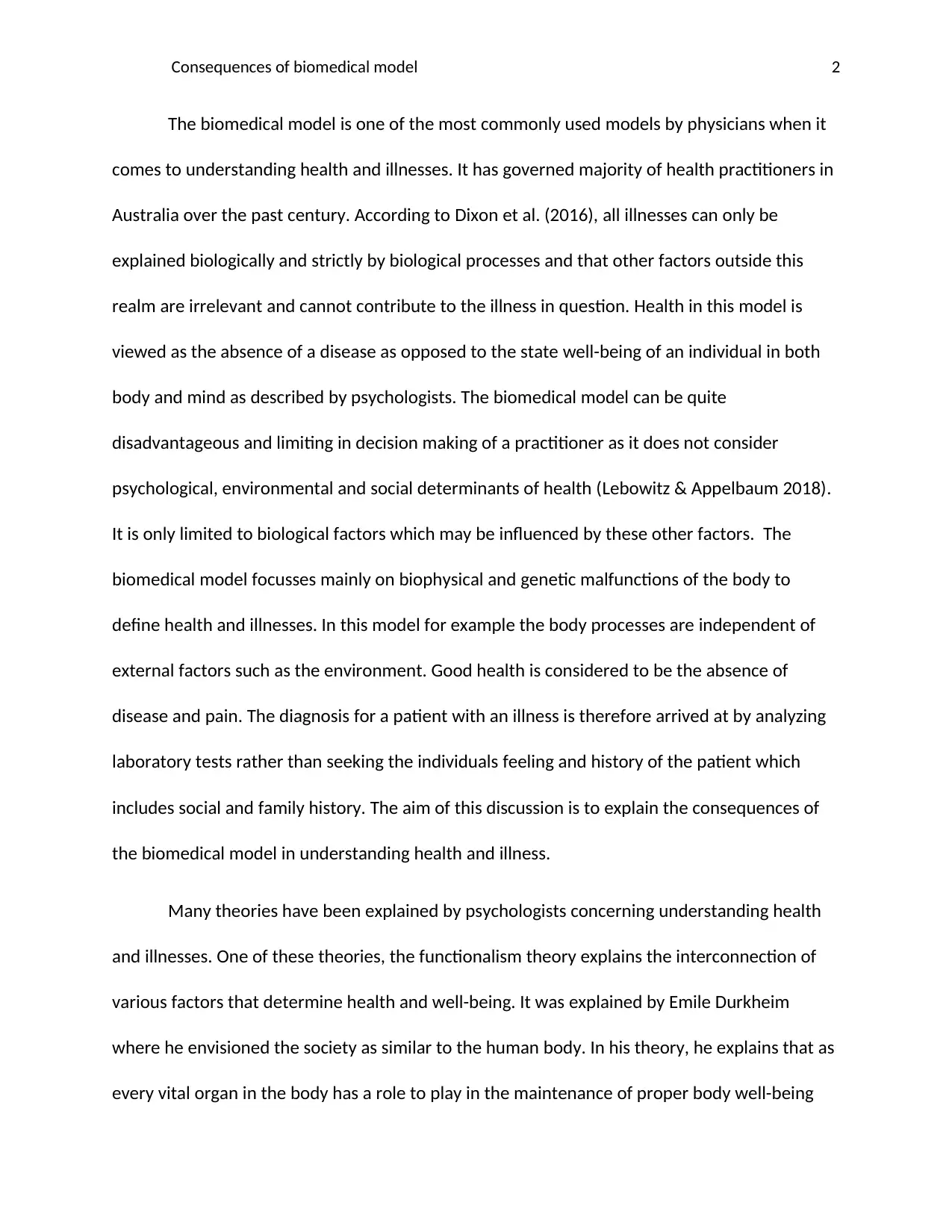
Consequences of biomedical model 2
The biomedical model is one of the most commonly used models by physicians when it
comes to understanding health and illnesses. It has governed majority of health practitioners in
Australia over the past century. According to Dixon et al. (2016), all illnesses can only be
explained biologically and strictly by biological processes and that other factors outside this
realm are irrelevant and cannot contribute to the illness in question. Health in this model is
viewed as the absence of a disease as opposed to the state well-being of an individual in both
body and mind as described by psychologists. The biomedical model can be quite
disadvantageous and limiting in decision making of a practitioner as it does not consider
psychological, environmental and social determinants of health (Lebowitz & Appelbaum 2018).
It is only limited to biological factors which may be influenced by these other factors. The
biomedical model focusses mainly on biophysical and genetic malfunctions of the body to
define health and illnesses. In this model for example the body processes are independent of
external factors such as the environment. Good health is considered to be the absence of
disease and pain. The diagnosis for a patient with an illness is therefore arrived at by analyzing
laboratory tests rather than seeking the individuals feeling and history of the patient which
includes social and family history. The aim of this discussion is to explain the consequences of
the biomedical model in understanding health and illness.
Many theories have been explained by psychologists concerning understanding health
and illnesses. One of these theories, the functionalism theory explains the interconnection of
various factors that determine health and well-being. It was explained by Emile Durkheim
where he envisioned the society as similar to the human body. In his theory, he explains that as
every vital organ in the body has a role to play in the maintenance of proper body well-being
The biomedical model is one of the most commonly used models by physicians when it
comes to understanding health and illnesses. It has governed majority of health practitioners in
Australia over the past century. According to Dixon et al. (2016), all illnesses can only be
explained biologically and strictly by biological processes and that other factors outside this
realm are irrelevant and cannot contribute to the illness in question. Health in this model is
viewed as the absence of a disease as opposed to the state well-being of an individual in both
body and mind as described by psychologists. The biomedical model can be quite
disadvantageous and limiting in decision making of a practitioner as it does not consider
psychological, environmental and social determinants of health (Lebowitz & Appelbaum 2018).
It is only limited to biological factors which may be influenced by these other factors. The
biomedical model focusses mainly on biophysical and genetic malfunctions of the body to
define health and illnesses. In this model for example the body processes are independent of
external factors such as the environment. Good health is considered to be the absence of
disease and pain. The diagnosis for a patient with an illness is therefore arrived at by analyzing
laboratory tests rather than seeking the individuals feeling and history of the patient which
includes social and family history. The aim of this discussion is to explain the consequences of
the biomedical model in understanding health and illness.
Many theories have been explained by psychologists concerning understanding health
and illnesses. One of these theories, the functionalism theory explains the interconnection of
various factors that determine health and well-being. It was explained by Emile Durkheim
where he envisioned the society as similar to the human body. In his theory, he explains that as
every vital organ in the body has a role to play in the maintenance of proper body well-being
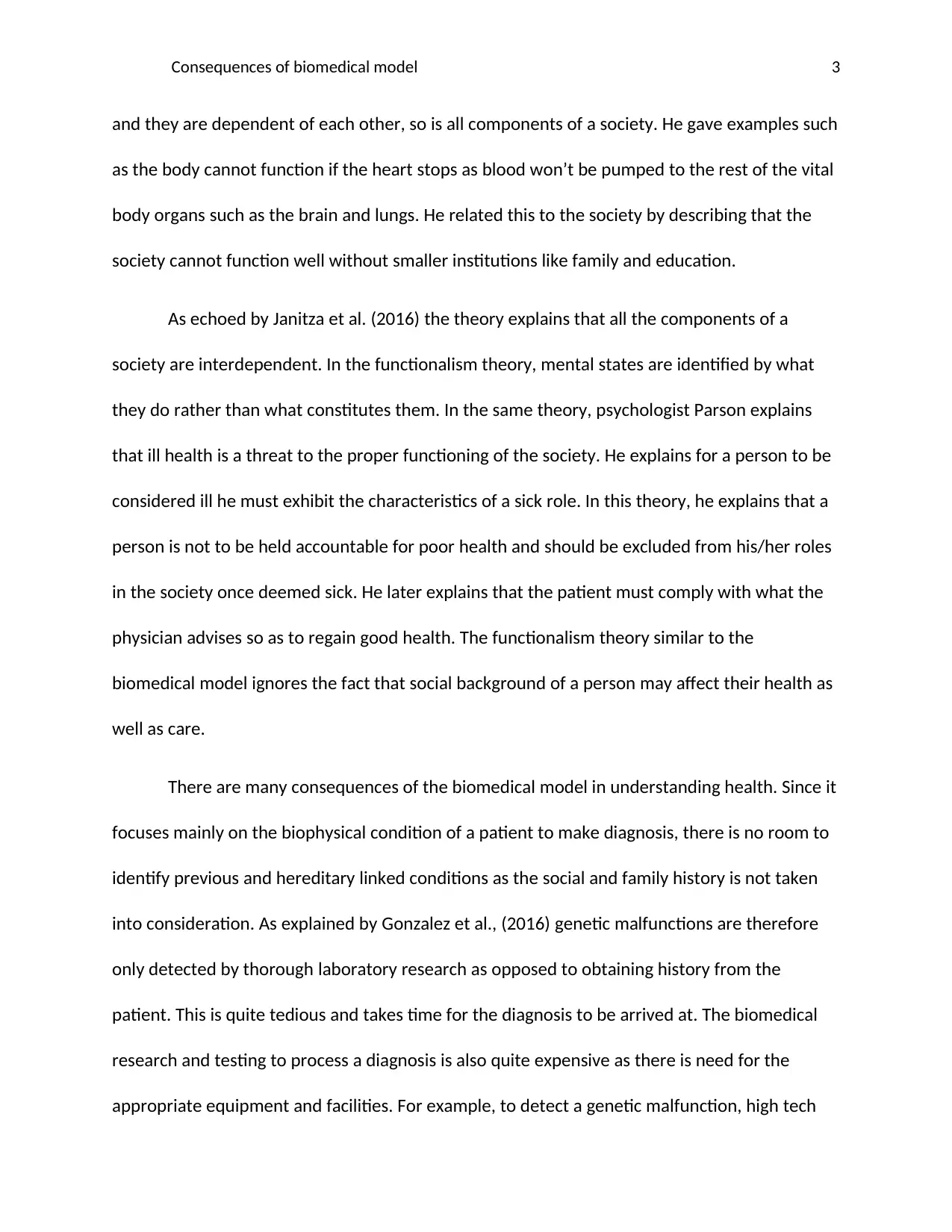
Consequences of biomedical model 3
and they are dependent of each other, so is all components of a society. He gave examples such
as the body cannot function if the heart stops as blood won’t be pumped to the rest of the vital
body organs such as the brain and lungs. He related this to the society by describing that the
society cannot function well without smaller institutions like family and education.
As echoed by Janitza et al. (2016) the theory explains that all the components of a
society are interdependent. In the functionalism theory, mental states are identified by what
they do rather than what constitutes them. In the same theory, psychologist Parson explains
that ill health is a threat to the proper functioning of the society. He explains for a person to be
considered ill he must exhibit the characteristics of a sick role. In this theory, he explains that a
person is not to be held accountable for poor health and should be excluded from his/her roles
in the society once deemed sick. He later explains that the patient must comply with what the
physician advises so as to regain good health. The functionalism theory similar to the
biomedical model ignores the fact that social background of a person may affect their health as
well as care.
There are many consequences of the biomedical model in understanding health. Since it
focuses mainly on the biophysical condition of a patient to make diagnosis, there is no room to
identify previous and hereditary linked conditions as the social and family history is not taken
into consideration. As explained by Gonzalez et al., (2016) genetic malfunctions are therefore
only detected by thorough laboratory research as opposed to obtaining history from the
patient. This is quite tedious and takes time for the diagnosis to be arrived at. The biomedical
research and testing to process a diagnosis is also quite expensive as there is need for the
appropriate equipment and facilities. For example, to detect a genetic malfunction, high tech
and they are dependent of each other, so is all components of a society. He gave examples such
as the body cannot function if the heart stops as blood won’t be pumped to the rest of the vital
body organs such as the brain and lungs. He related this to the society by describing that the
society cannot function well without smaller institutions like family and education.
As echoed by Janitza et al. (2016) the theory explains that all the components of a
society are interdependent. In the functionalism theory, mental states are identified by what
they do rather than what constitutes them. In the same theory, psychologist Parson explains
that ill health is a threat to the proper functioning of the society. He explains for a person to be
considered ill he must exhibit the characteristics of a sick role. In this theory, he explains that a
person is not to be held accountable for poor health and should be excluded from his/her roles
in the society once deemed sick. He later explains that the patient must comply with what the
physician advises so as to regain good health. The functionalism theory similar to the
biomedical model ignores the fact that social background of a person may affect their health as
well as care.
There are many consequences of the biomedical model in understanding health. Since it
focuses mainly on the biophysical condition of a patient to make diagnosis, there is no room to
identify previous and hereditary linked conditions as the social and family history is not taken
into consideration. As explained by Gonzalez et al., (2016) genetic malfunctions are therefore
only detected by thorough laboratory research as opposed to obtaining history from the
patient. This is quite tedious and takes time for the diagnosis to be arrived at. The biomedical
research and testing to process a diagnosis is also quite expensive as there is need for the
appropriate equipment and facilities. For example, to detect a genetic malfunction, high tech
⊘ This is a preview!⊘
Do you want full access?
Subscribe today to unlock all pages.

Trusted by 1+ million students worldwide
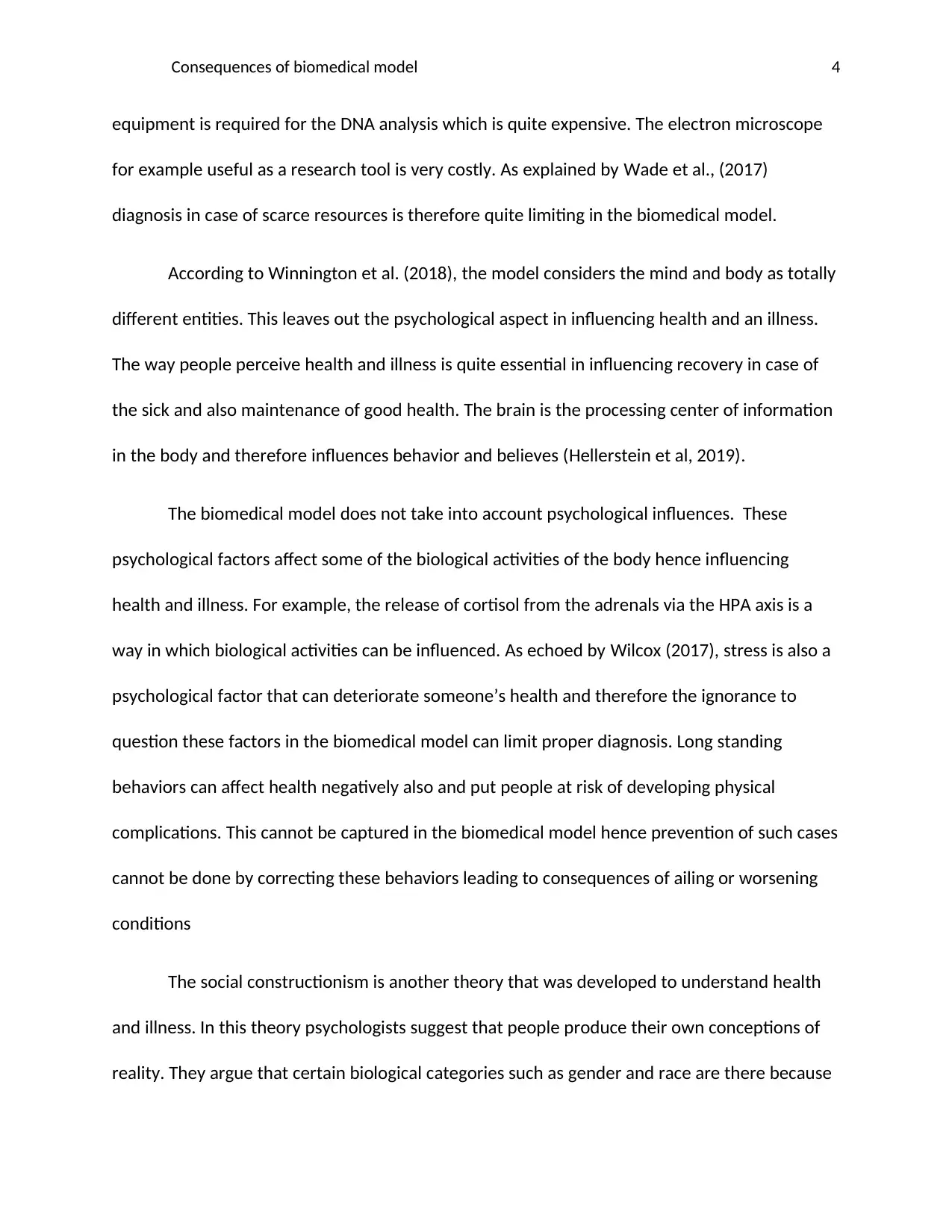
Consequences of biomedical model 4
equipment is required for the DNA analysis which is quite expensive. The electron microscope
for example useful as a research tool is very costly. As explained by Wade et al., (2017)
diagnosis in case of scarce resources is therefore quite limiting in the biomedical model.
According to Winnington et al. (2018), the model considers the mind and body as totally
different entities. This leaves out the psychological aspect in influencing health and an illness.
The way people perceive health and illness is quite essential in influencing recovery in case of
the sick and also maintenance of good health. The brain is the processing center of information
in the body and therefore influences behavior and believes (Hellerstein et al, 2019).
The biomedical model does not take into account psychological influences. These
psychological factors affect some of the biological activities of the body hence influencing
health and illness. For example, the release of cortisol from the adrenals via the HPA axis is a
way in which biological activities can be influenced. As echoed by Wilcox (2017), stress is also a
psychological factor that can deteriorate someone’s health and therefore the ignorance to
question these factors in the biomedical model can limit proper diagnosis. Long standing
behaviors can affect health negatively also and put people at risk of developing physical
complications. This cannot be captured in the biomedical model hence prevention of such cases
cannot be done by correcting these behaviors leading to consequences of ailing or worsening
conditions
The social constructionism is another theory that was developed to understand health
and illness. In this theory psychologists suggest that people produce their own conceptions of
reality. They argue that certain biological categories such as gender and race are there because
equipment is required for the DNA analysis which is quite expensive. The electron microscope
for example useful as a research tool is very costly. As explained by Wade et al., (2017)
diagnosis in case of scarce resources is therefore quite limiting in the biomedical model.
According to Winnington et al. (2018), the model considers the mind and body as totally
different entities. This leaves out the psychological aspect in influencing health and an illness.
The way people perceive health and illness is quite essential in influencing recovery in case of
the sick and also maintenance of good health. The brain is the processing center of information
in the body and therefore influences behavior and believes (Hellerstein et al, 2019).
The biomedical model does not take into account psychological influences. These
psychological factors affect some of the biological activities of the body hence influencing
health and illness. For example, the release of cortisol from the adrenals via the HPA axis is a
way in which biological activities can be influenced. As echoed by Wilcox (2017), stress is also a
psychological factor that can deteriorate someone’s health and therefore the ignorance to
question these factors in the biomedical model can limit proper diagnosis. Long standing
behaviors can affect health negatively also and put people at risk of developing physical
complications. This cannot be captured in the biomedical model hence prevention of such cases
cannot be done by correcting these behaviors leading to consequences of ailing or worsening
conditions
The social constructionism is another theory that was developed to understand health
and illness. In this theory psychologists suggest that people produce their own conceptions of
reality. They argue that certain biological categories such as gender and race are there because
Paraphrase This Document
Need a fresh take? Get an instant paraphrase of this document with our AI Paraphraser
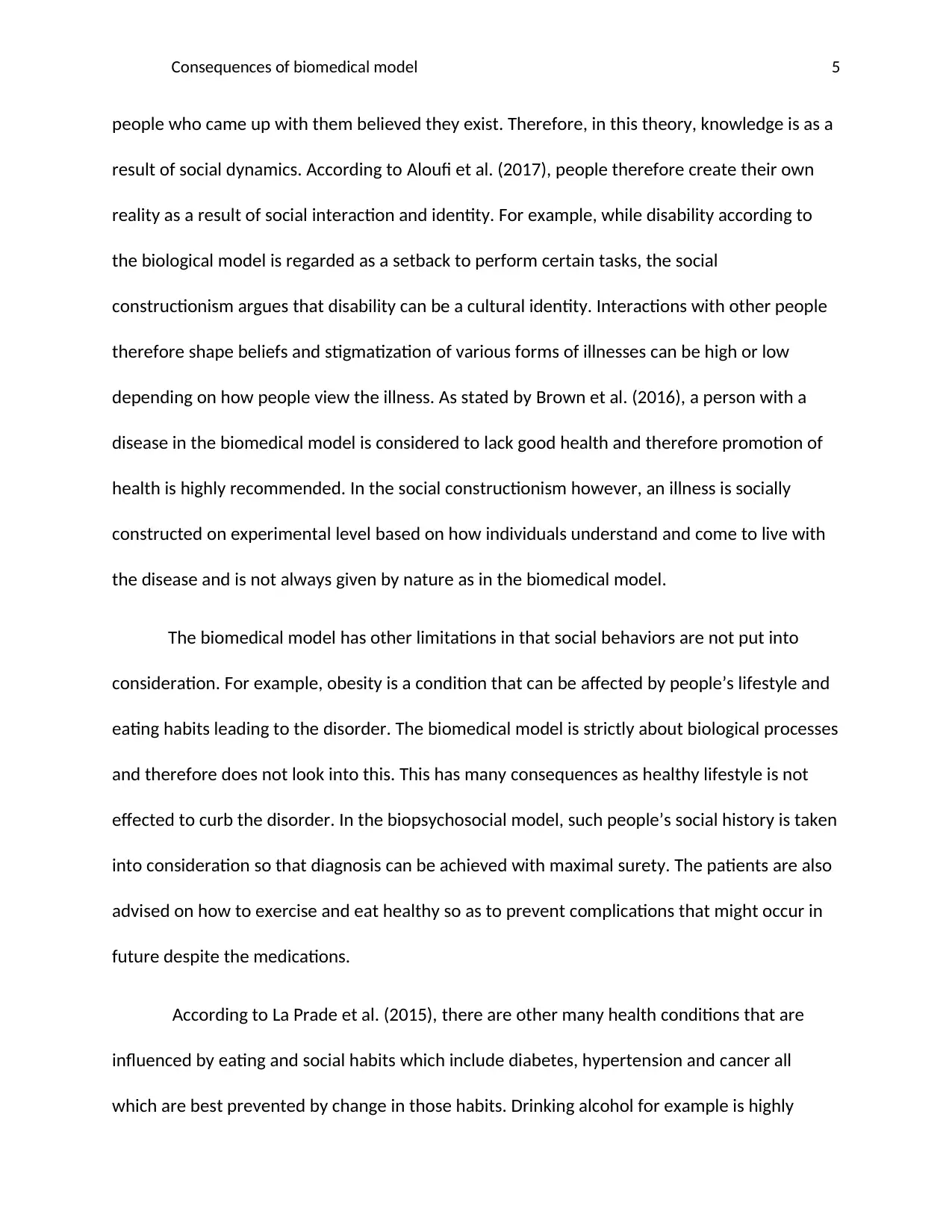
Consequences of biomedical model 5
people who came up with them believed they exist. Therefore, in this theory, knowledge is as a
result of social dynamics. According to Aloufi et al. (2017), people therefore create their own
reality as a result of social interaction and identity. For example, while disability according to
the biological model is regarded as a setback to perform certain tasks, the social
constructionism argues that disability can be a cultural identity. Interactions with other people
therefore shape beliefs and stigmatization of various forms of illnesses can be high or low
depending on how people view the illness. As stated by Brown et al. (2016), a person with a
disease in the biomedical model is considered to lack good health and therefore promotion of
health is highly recommended. In the social constructionism however, an illness is socially
constructed on experimental level based on how individuals understand and come to live with
the disease and is not always given by nature as in the biomedical model.
The biomedical model has other limitations in that social behaviors are not put into
consideration. For example, obesity is a condition that can be affected by people’s lifestyle and
eating habits leading to the disorder. The biomedical model is strictly about biological processes
and therefore does not look into this. This has many consequences as healthy lifestyle is not
effected to curb the disorder. In the biopsychosocial model, such people’s social history is taken
into consideration so that diagnosis can be achieved with maximal surety. The patients are also
advised on how to exercise and eat healthy so as to prevent complications that might occur in
future despite the medications.
According to La Prade et al. (2015), there are other many health conditions that are
influenced by eating and social habits which include diabetes, hypertension and cancer all
which are best prevented by change in those habits. Drinking alcohol for example is highly
people who came up with them believed they exist. Therefore, in this theory, knowledge is as a
result of social dynamics. According to Aloufi et al. (2017), people therefore create their own
reality as a result of social interaction and identity. For example, while disability according to
the biological model is regarded as a setback to perform certain tasks, the social
constructionism argues that disability can be a cultural identity. Interactions with other people
therefore shape beliefs and stigmatization of various forms of illnesses can be high or low
depending on how people view the illness. As stated by Brown et al. (2016), a person with a
disease in the biomedical model is considered to lack good health and therefore promotion of
health is highly recommended. In the social constructionism however, an illness is socially
constructed on experimental level based on how individuals understand and come to live with
the disease and is not always given by nature as in the biomedical model.
The biomedical model has other limitations in that social behaviors are not put into
consideration. For example, obesity is a condition that can be affected by people’s lifestyle and
eating habits leading to the disorder. The biomedical model is strictly about biological processes
and therefore does not look into this. This has many consequences as healthy lifestyle is not
effected to curb the disorder. In the biopsychosocial model, such people’s social history is taken
into consideration so that diagnosis can be achieved with maximal surety. The patients are also
advised on how to exercise and eat healthy so as to prevent complications that might occur in
future despite the medications.
According to La Prade et al. (2015), there are other many health conditions that are
influenced by eating and social habits which include diabetes, hypertension and cancer all
which are best prevented by change in those habits. Drinking alcohol for example is highly
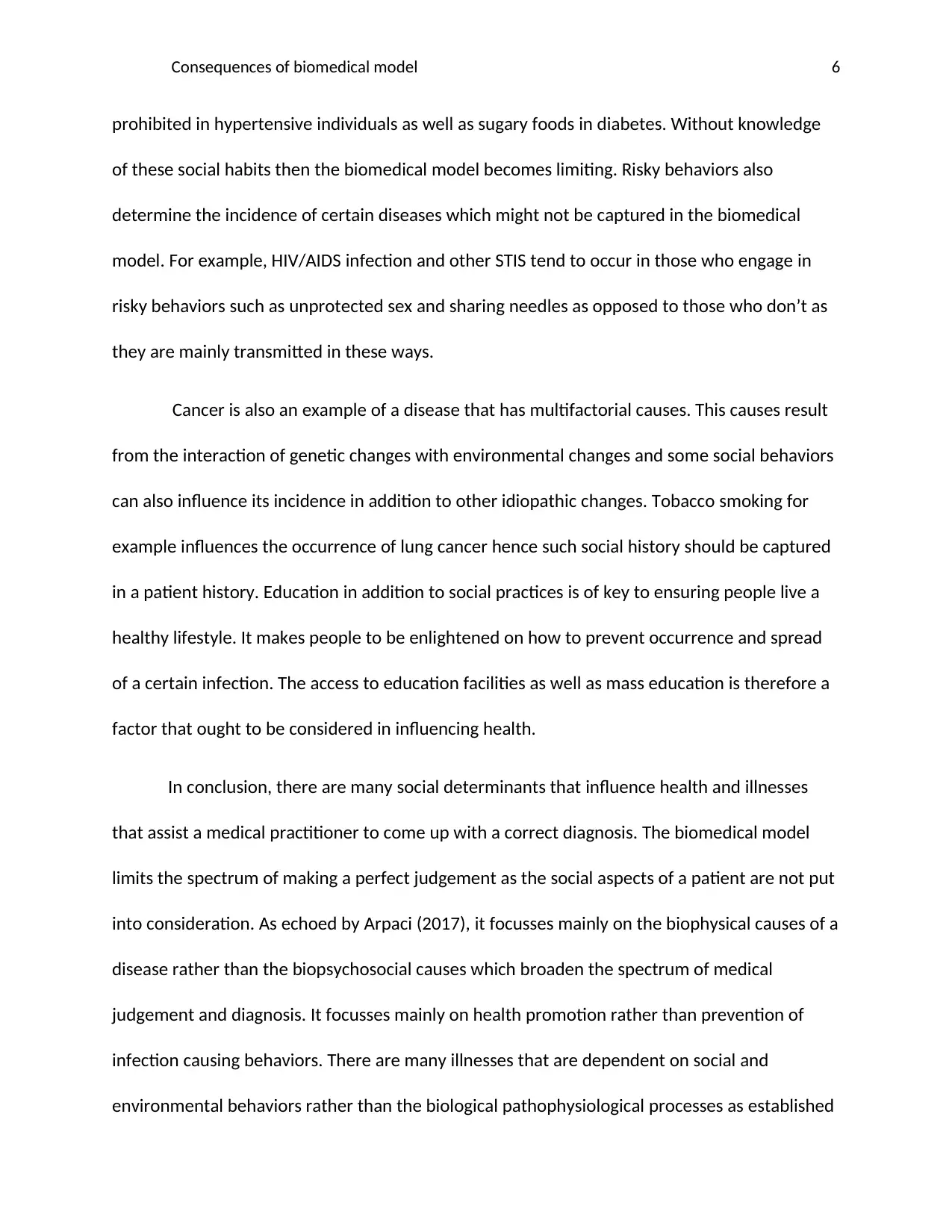
Consequences of biomedical model 6
prohibited in hypertensive individuals as well as sugary foods in diabetes. Without knowledge
of these social habits then the biomedical model becomes limiting. Risky behaviors also
determine the incidence of certain diseases which might not be captured in the biomedical
model. For example, HIV/AIDS infection and other STIS tend to occur in those who engage in
risky behaviors such as unprotected sex and sharing needles as opposed to those who don’t as
they are mainly transmitted in these ways.
Cancer is also an example of a disease that has multifactorial causes. This causes result
from the interaction of genetic changes with environmental changes and some social behaviors
can also influence its incidence in addition to other idiopathic changes. Tobacco smoking for
example influences the occurrence of lung cancer hence such social history should be captured
in a patient history. Education in addition to social practices is of key to ensuring people live a
healthy lifestyle. It makes people to be enlightened on how to prevent occurrence and spread
of a certain infection. The access to education facilities as well as mass education is therefore a
factor that ought to be considered in influencing health.
In conclusion, there are many social determinants that influence health and illnesses
that assist a medical practitioner to come up with a correct diagnosis. The biomedical model
limits the spectrum of making a perfect judgement as the social aspects of a patient are not put
into consideration. As echoed by Arpaci (2017), it focusses mainly on the biophysical causes of a
disease rather than the biopsychosocial causes which broaden the spectrum of medical
judgement and diagnosis. It focusses mainly on health promotion rather than prevention of
infection causing behaviors. There are many illnesses that are dependent on social and
environmental behaviors rather than the biological pathophysiological processes as established
prohibited in hypertensive individuals as well as sugary foods in diabetes. Without knowledge
of these social habits then the biomedical model becomes limiting. Risky behaviors also
determine the incidence of certain diseases which might not be captured in the biomedical
model. For example, HIV/AIDS infection and other STIS tend to occur in those who engage in
risky behaviors such as unprotected sex and sharing needles as opposed to those who don’t as
they are mainly transmitted in these ways.
Cancer is also an example of a disease that has multifactorial causes. This causes result
from the interaction of genetic changes with environmental changes and some social behaviors
can also influence its incidence in addition to other idiopathic changes. Tobacco smoking for
example influences the occurrence of lung cancer hence such social history should be captured
in a patient history. Education in addition to social practices is of key to ensuring people live a
healthy lifestyle. It makes people to be enlightened on how to prevent occurrence and spread
of a certain infection. The access to education facilities as well as mass education is therefore a
factor that ought to be considered in influencing health.
In conclusion, there are many social determinants that influence health and illnesses
that assist a medical practitioner to come up with a correct diagnosis. The biomedical model
limits the spectrum of making a perfect judgement as the social aspects of a patient are not put
into consideration. As echoed by Arpaci (2017), it focusses mainly on the biophysical causes of a
disease rather than the biopsychosocial causes which broaden the spectrum of medical
judgement and diagnosis. It focusses mainly on health promotion rather than prevention of
infection causing behaviors. There are many illnesses that are dependent on social and
environmental behaviors rather than the biological pathophysiological processes as established
⊘ This is a preview!⊘
Do you want full access?
Subscribe today to unlock all pages.

Trusted by 1+ million students worldwide
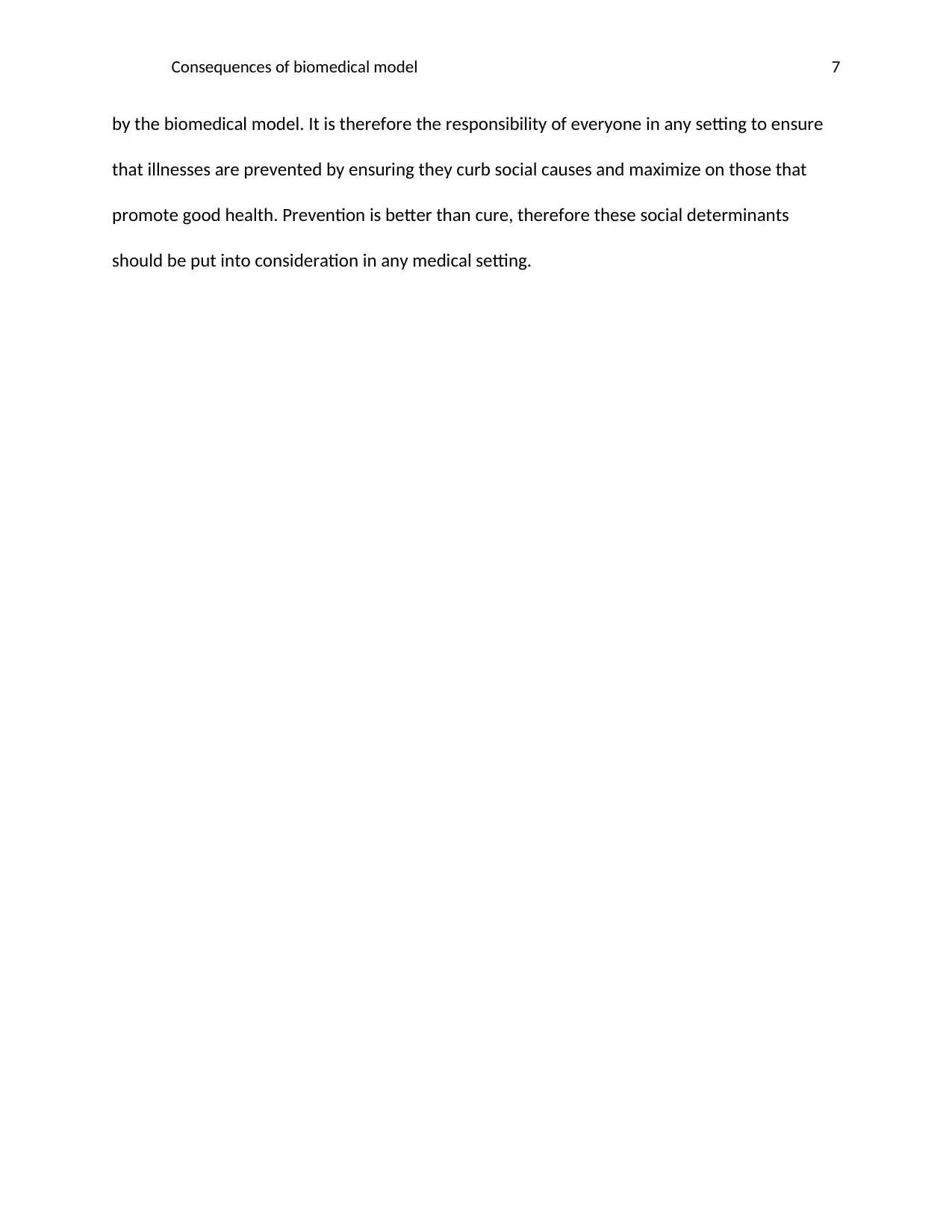
Consequences of biomedical model 7
by the biomedical model. It is therefore the responsibility of everyone in any setting to ensure
that illnesses are prevented by ensuring they curb social causes and maximize on those that
promote good health. Prevention is better than cure, therefore these social determinants
should be put into consideration in any medical setting.
by the biomedical model. It is therefore the responsibility of everyone in any setting to ensure
that illnesses are prevented by ensuring they curb social causes and maximize on those that
promote good health. Prevention is better than cure, therefore these social determinants
should be put into consideration in any medical setting.
Paraphrase This Document
Need a fresh take? Get an instant paraphrase of this document with our AI Paraphraser

Consequences of biomedical model 8
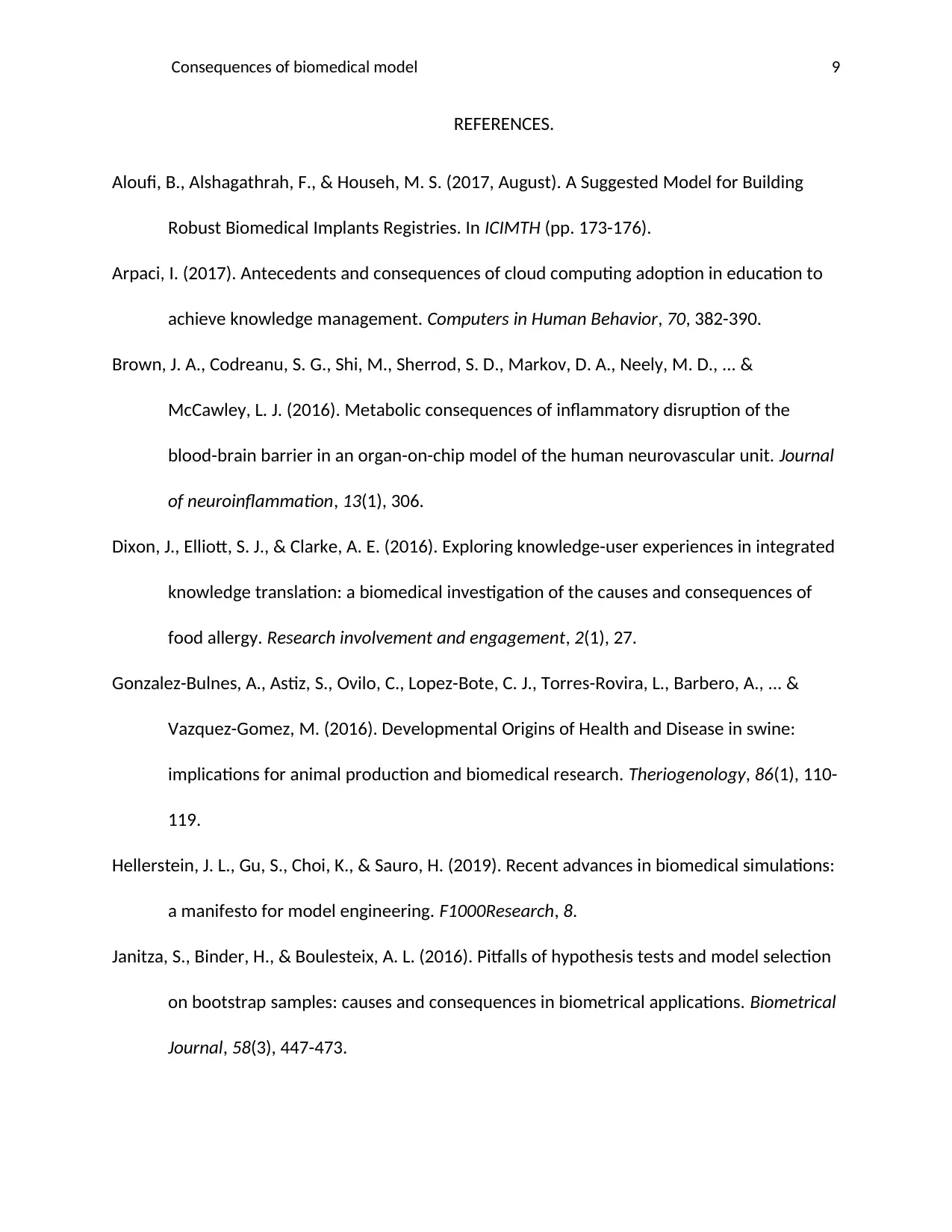
Consequences of biomedical model 9
REFERENCES.
Aloufi, B., Alshagathrah, F., & Househ, M. S. (2017, August). A Suggested Model for Building
Robust Biomedical Implants Registries. In ICIMTH (pp. 173-176).
Arpaci, I. (2017). Antecedents and consequences of cloud computing adoption in education to
achieve knowledge management. Computers in Human Behavior, 70, 382-390.
Brown, J. A., Codreanu, S. G., Shi, M., Sherrod, S. D., Markov, D. A., Neely, M. D., ... &
McCawley, L. J. (2016). Metabolic consequences of inflammatory disruption of the
blood-brain barrier in an organ-on-chip model of the human neurovascular unit. Journal
of neuroinflammation, 13(1), 306.
Dixon, J., Elliott, S. J., & Clarke, A. E. (2016). Exploring knowledge-user experiences in integrated
knowledge translation: a biomedical investigation of the causes and consequences of
food allergy. Research involvement and engagement, 2(1), 27.
Gonzalez-Bulnes, A., Astiz, S., Ovilo, C., Lopez-Bote, C. J., Torres-Rovira, L., Barbero, A., ... &
Vazquez-Gomez, M. (2016). Developmental Origins of Health and Disease in swine:
implications for animal production and biomedical research. Theriogenology, 86(1), 110-
119.
Hellerstein, J. L., Gu, S., Choi, K., & Sauro, H. (2019). Recent advances in biomedical simulations:
a manifesto for model engineering. F1000Research, 8.
Janitza, S., Binder, H., & Boulesteix, A. L. (2016). Pitfalls of hypothesis tests and model selection
on bootstrap samples: causes and consequences in biometrical applications. Biometrical
Journal, 58(3), 447-473.
REFERENCES.
Aloufi, B., Alshagathrah, F., & Househ, M. S. (2017, August). A Suggested Model for Building
Robust Biomedical Implants Registries. In ICIMTH (pp. 173-176).
Arpaci, I. (2017). Antecedents and consequences of cloud computing adoption in education to
achieve knowledge management. Computers in Human Behavior, 70, 382-390.
Brown, J. A., Codreanu, S. G., Shi, M., Sherrod, S. D., Markov, D. A., Neely, M. D., ... &
McCawley, L. J. (2016). Metabolic consequences of inflammatory disruption of the
blood-brain barrier in an organ-on-chip model of the human neurovascular unit. Journal
of neuroinflammation, 13(1), 306.
Dixon, J., Elliott, S. J., & Clarke, A. E. (2016). Exploring knowledge-user experiences in integrated
knowledge translation: a biomedical investigation of the causes and consequences of
food allergy. Research involvement and engagement, 2(1), 27.
Gonzalez-Bulnes, A., Astiz, S., Ovilo, C., Lopez-Bote, C. J., Torres-Rovira, L., Barbero, A., ... &
Vazquez-Gomez, M. (2016). Developmental Origins of Health and Disease in swine:
implications for animal production and biomedical research. Theriogenology, 86(1), 110-
119.
Hellerstein, J. L., Gu, S., Choi, K., & Sauro, H. (2019). Recent advances in biomedical simulations:
a manifesto for model engineering. F1000Research, 8.
Janitza, S., Binder, H., & Boulesteix, A. L. (2016). Pitfalls of hypothesis tests and model selection
on bootstrap samples: causes and consequences in biometrical applications. Biometrical
Journal, 58(3), 447-473.
⊘ This is a preview!⊘
Do you want full access?
Subscribe today to unlock all pages.

Trusted by 1+ million students worldwide
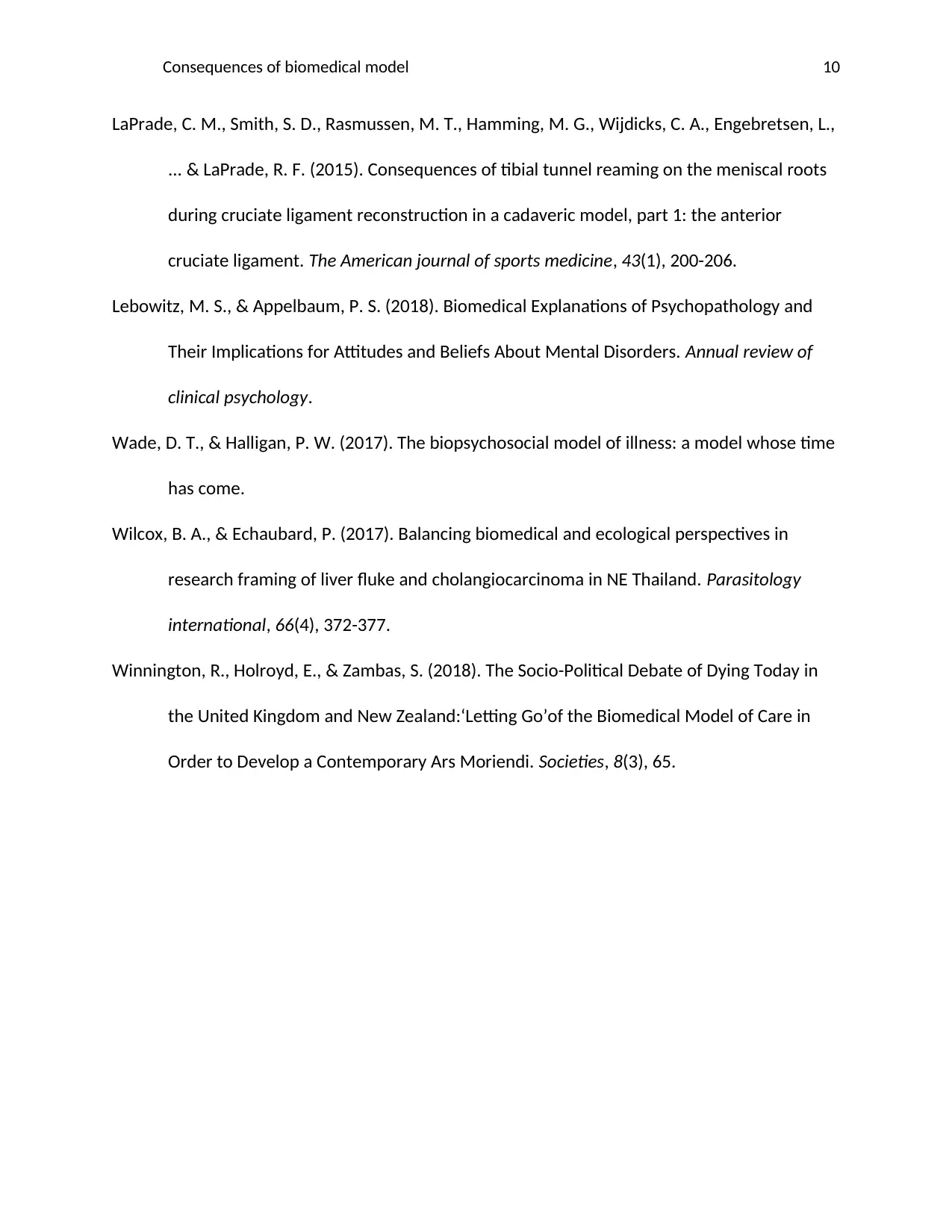
Consequences of biomedical model 10
LaPrade, C. M., Smith, S. D., Rasmussen, M. T., Hamming, M. G., Wijdicks, C. A., Engebretsen, L.,
... & LaPrade, R. F. (2015). Consequences of tibial tunnel reaming on the meniscal roots
during cruciate ligament reconstruction in a cadaveric model, part 1: the anterior
cruciate ligament. The American journal of sports medicine, 43(1), 200-206.
Lebowitz, M. S., & Appelbaum, P. S. (2018). Biomedical Explanations of Psychopathology and
Their Implications for Attitudes and Beliefs About Mental Disorders. Annual review of
clinical psychology.
Wade, D. T., & Halligan, P. W. (2017). The biopsychosocial model of illness: a model whose time
has come.
Wilcox, B. A., & Echaubard, P. (2017). Balancing biomedical and ecological perspectives in
research framing of liver fluke and cholangiocarcinoma in NE Thailand. Parasitology
international, 66(4), 372-377.
Winnington, R., Holroyd, E., & Zambas, S. (2018). The Socio-Political Debate of Dying Today in
the United Kingdom and New Zealand:‘Letting Go’of the Biomedical Model of Care in
Order to Develop a Contemporary Ars Moriendi. Societies, 8(3), 65.
LaPrade, C. M., Smith, S. D., Rasmussen, M. T., Hamming, M. G., Wijdicks, C. A., Engebretsen, L.,
... & LaPrade, R. F. (2015). Consequences of tibial tunnel reaming on the meniscal roots
during cruciate ligament reconstruction in a cadaveric model, part 1: the anterior
cruciate ligament. The American journal of sports medicine, 43(1), 200-206.
Lebowitz, M. S., & Appelbaum, P. S. (2018). Biomedical Explanations of Psychopathology and
Their Implications for Attitudes and Beliefs About Mental Disorders. Annual review of
clinical psychology.
Wade, D. T., & Halligan, P. W. (2017). The biopsychosocial model of illness: a model whose time
has come.
Wilcox, B. A., & Echaubard, P. (2017). Balancing biomedical and ecological perspectives in
research framing of liver fluke and cholangiocarcinoma in NE Thailand. Parasitology
international, 66(4), 372-377.
Winnington, R., Holroyd, E., & Zambas, S. (2018). The Socio-Political Debate of Dying Today in
the United Kingdom and New Zealand:‘Letting Go’of the Biomedical Model of Care in
Order to Develop a Contemporary Ars Moriendi. Societies, 8(3), 65.
1 out of 10
Related Documents
Your All-in-One AI-Powered Toolkit for Academic Success.
+13062052269
info@desklib.com
Available 24*7 on WhatsApp / Email
![[object Object]](/_next/static/media/star-bottom.7253800d.svg)
Unlock your academic potential
Copyright © 2020–2025 A2Z Services. All Rights Reserved. Developed and managed by ZUCOL.





